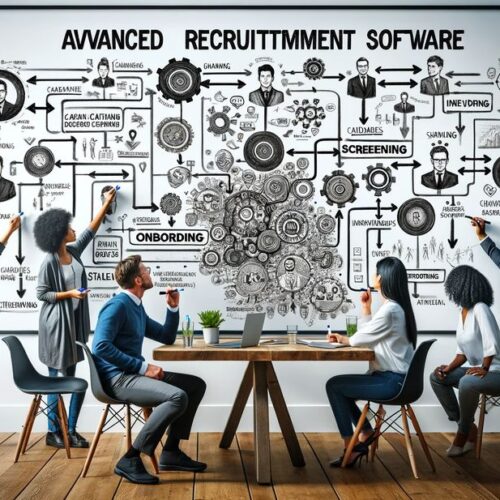Why Best Recruitment Software Review is Essential for Finding the Right Solution
Understanding Recruitment Software
Recruitment software has revolutionised the hiring process, offering tools that streamline and automate various aspects of recruitment. These systems, ranging from applicant tracking systems (ATS) to more comprehensive human resources management systems (HRMS), have become indispensable in the modern job market. They enable businesses to manage job postings, applicant tracking, candidate screening, and the interview process more efficiently. The integration of such software into the recruitment process not only saves time but also helps in attracting the right talent by enhancing the overall recruitment strategy.
The Role of Recruitment Software in Modern Hiring
The role of recruitment software in modern hiring cannot be overstated. It allows recruiters to reach a wider pool of candidates, manage applications more effectively, and reduce the time to hire. Key functionalities like automated resume screening, AI-driven candidate matching, and communication tools significantly enhance the efficiency of the recruitment process. By automating mundane tasks, recruiters can focus on more strategic aspects like candidate engagement and employer branding, which are crucial in today’s competitive job market.
Evolution of Recruitment Tools
The evolution of recruitment tools reflects the changing landscape of the workforce and the growing needs of businesses. Initially, recruitment software was primarily used to track applications and manage resumes. However, with advancements in technology, these tools have evolved to offer sophisticated features like AI-driven analytics, predictive hiring, and integration with social media platforms. This evolution signifies a shift towards more proactive and strategic recruitment approaches, leveraging data and technology to make better hiring decisions.
Key Features to Look for in Recruitment Software
When selecting recruitment software, there are several key features to consider. User-friendliness and intuitive design are paramount for ensuring that the software can be effectively used by recruiters and hiring managers. Integration capabilities with existing HR systems and tools are essential for a seamless workflow. Other vital features include robust candidate sourcing tools, efficient application tracking systems, customisable job posting options, and comprehensive reporting and analytics capabilities. These features collectively enhance the recruitment process, making it more efficient and effective.

Evaluating Recruitment Software for Small Businesses
For small businesses, the right recruitment software can be a game-changer. It’s important to find a solution that is not only cost-effective but also tailored to the unique needs of a smaller enterprise. Small businesses often require recruitment software that is easy to implement, requires minimal training, and offers scalability as the business grows. The focus should be on finding software that streamlines the recruitment process without overwhelming the users with unnecessary complexity or cost.
Tailoring Solutions for Small Companies
Recruitment software for small businesses should be designed to meet their specific needs. This includes features like simplified workflows, easy-to-use interfaces, and flexibility to adapt to the changing needs of the business. The software should offer essential functionalities like candidate tracking, interview scheduling, and communication tools without the complexity and cost associated with larger systems. A tailored solution helps small businesses to compete effectively for top talent, despite having fewer resources compared to larger companies.
The Importance of Scalability and Flexibility
Scalability and flexibility are crucial features for recruitment software, especially for small businesses. As these businesses grow, their recruitment needs evolve, and their software should be able to adapt accordingly. Scalable software allows for additional features or users to be added as needed, without requiring a complete system overhaul. Flexibility in terms of customisation options and integration with other tools ensures that the software remains relevant and useful as the business’s recruitment strategies and processes evolve.
Overcoming Budget Constraints with Smart Choices
Budget constraints are a common challenge for small businesses when investing in recruitment software. It’s crucial to make smart choices that balance cost and functionality. Opting for software with a pay-as-you-go model or choosing features a la carte can be cost-effective. Additionally, businesses should look for solutions that offer essential features without the frills, thus providing value for money. It’s also advisable to consider long-term costs such as maintenance and upgrades, ensuring the investment remains affordable over time.
Navigating Recruitment Software Reviews
Making sense of recruitment software reviews is a critical part of the selection process. Reviews and testimonials provide insights into user experiences, helping potential buyers understand the strengths and weaknesses of different software. However, it’s important to approach these reviews critically, understanding that individual experiences can vary and that some reviews may be biased.
Reading Between the Lines of User Reviews
When reading user reviews, it’s important to look for patterns and common themes. Consistent complaints or praises about specific features can be telling. It’s also helpful to consider the context of the review, such as the size and industry of the business, as this can impact the relevance of the feedback to your own situation.
Identifying Red Flags in Software Reviews
Certain red flags in software reviews should prompt caution. These include frequent mentions of poor customer support, bugs and technical issues, or difficulties with software integration. Reviews that highlight a lack of updates or improvements over time can also indicate a vendor’s lack of commitment to their product.
Utilising Professional Reviews and Ratings
In addition to user reviews, professional reviews and ratings from industry experts can provide a more objective assessment of recruitment software. These reviews often offer comprehensive evaluations, comparing features, usability, and value for money across different products. Such insights can be invaluable in making an informed decision.
Recruitment Software Pricing Models
Understanding the pricing models of recruitment software is essential for making a cost-effective choice. Pricing can vary significantly between providers and often depends on the range of features offered, the number of users, and the level of customisation required.
Breaking Down Pricing Structures
Recruitment software pricing structures can range from simple flat-rate monthly fees to more complex tiered pricing models based on usage or features. Some vendors offer free versions with basic functionalities, which can be a good starting point for small businesses. Understanding what each pricing tier offers and how it aligns with your business needs is key to choosing the right software.
Cost vs. Value in Recruitment Software
When evaluating the cost of recruitment software, it’s important to consider the value it brings to your recruitment process. Software that improves efficiency, reduces time-to-hire, and enhances candidate quality can offer significant return on investment, even if it comes with a higher price tag. Balancing cost with potential benefits is crucial in determining the most suitable software for your business.
Hidden Costs in Recruitment Software
Potential hidden costs in recruitment software include charges for additional features, support, training, and system upgrades. It’s important to inquire about these costs upfront and factor them into the total cost of ownership. Being aware of and planning for these additional expenses can prevent surprises and ensure a sustainable investment.
Integrating Recruitment Software with Existing Systems
Integrating new recruitment software with existing systems is a crucial step for maintaining a seamless workflow. This integration involves ensuring that the new software works well with other HR systems, databases, and productivity tools already in use. The key to successful integration is compatibility and ease of data transfer, which helps in maintaining data integrity and operational continuity.
Seamless Integration with Current Workflows
The ideal recruitment software should integrate seamlessly into existing business workflows. This means it should complement and enhance current processes rather than requiring a complete overhaul. Features like API access and customisable data fields can help ensure that the software fits well with the specific needs and existing systems of a business.
Compatibility with Other Business Tools
Compatibility with other business tools is essential for a cohesive and efficient work environment. Recruitment software should ideally integrate with email platforms, calendar systems, HR management software, and any other tools that are part of the recruitment process. This integration helps in automating tasks like scheduling interviews, sending notifications, and updating candidate records, thereby streamlining the entire recruitment process.
Data Migration and Security Concerns
When integrating new software, data migration and security are paramount. Ensuring that candidate and employee data is transferred securely and accurately is a key concern. The recruitment software should offer robust data migration tools and adhere to strict data security protocols. Compliance with data protection regulations like GDPR is also critical to protect the privacy of candidates and maintain trust.
Recruitment Software and Candidate Experience
Enhancing the candidate experience is a critical component of successful recruitment strategies. Recruitment software plays a significant role in this by automating and streamlining the application process, making it more user-friendly and accessible.
Enhancing Candidate Engagement
Recruitment software can significantly enhance candidate engagement by providing a more interactive and responsive application process. Features like automated responses, real-time application tracking, and personalised communication can make candidates feel more valued and engaged throughout the recruitment process.
Streamlining the Application Process
Streamlining the application process is essential for attracting top talent. Recruitment software can simplify the application process by reducing the number of steps and automating routine tasks. This not only makes it easier for candidates to apply but also speeds up the screening and selection process for recruiters.
Providing Feedback and Communication Channels
Effective communication is key to maintaining candidate interest and engagement. Recruitment software should offer tools for timely and clear communication, including automated feedback, interview scheduling, and regular updates. This transparency helps in building a positive candidate experience and enhances the employer brand.
Recruitment Analytics and Reporting
In today’s data-driven world, recruitment analytics and reporting play a vital role in shaping effective recruitment strategies. Recruitment software often comes with analytics tools that provide insights into various aspects of the hiring process.
Tracking Recruitment Metrics
Recruitment metrics such as time-to-hire, cost-per-hire, and candidate source effectiveness are crucial for assessing the efficiency of recruitment strategies. Recruitment software with robust analytics capabilities can track these metrics, offering valuable insights for continuous improvement.
Making Data-Driven Decisions
Data-driven decision-making is essential for optimising recruitment processes. Recruitment software can provide detailed reports and analytics, helping businesses to identify trends, pinpoint inefficiencies, and make informed decisions about future recruitment strategies.
Analysing Recruitment Process Efficiency
Analysing the overall efficiency of the recruitment process is crucial for continuous improvement. Recruitment software can help identify bottlenecks, assess the effectiveness of different recruitment channels, and provide actionable insights to enhance the recruitment process.
Legal and Compliance Considerations
In the realm of recruitment software, legal and compliance issues are of paramount importance. These considerations are not just about adhering to laws and regulations but also about protecting the rights and privacy of candidates and employees.
Ensuring GDPR Compliance
For businesses operating in or recruiting from the European Union, GDPR compliance is a critical aspect of any recruitment software. The software must be designed to handle personal data securely, with features that allow for consent management, data access, and the right to be forgotten. Ensuring GDPR compliance not only protects the business from legal repercussions but also reinforces its commitment to data privacy.
Navigating Employment Laws
Different regions and countries have varying employment laws, and recruitment software should be adaptable to these legal requirements. This includes compliance with equal opportunity employment laws, anti-discrimination policies, and other relevant legislation. A good recruitment software will provide features that help in maintaining legal compliance throughout the recruitment process.
Data Privacy and Security Measures
Data privacy and security are crucial in the digital age, particularly when handling sensitive personal information. Recruitment software must have robust security protocols in place, including data encryption, secure data storage, and regular security audits. Protecting candidate data is not only a legal obligation but also a matter of trust and integrity for the organisation.
User Experience and Interface Design
The user experience and interface design of recruitment software play a significant role in its effectiveness and adoption. A well-designed interface can significantly enhance the productivity and satisfaction of its users.
Intuitive Design for Efficient Use
An intuitive and user-friendly interface is essential for ensuring that the recruitment software is accessible and easy to use. This includes a clean layout, clear navigation, and simple workflows. An intuitive design reduces the learning curve and allows users to focus more on strategic aspects of recruitment rather than struggling with the software.
Customisation and Personalisation Options
Customisation and personalisation options allow businesses to tailor the software to their specific recruitment processes and preferences. This could include customisable application forms, workflow automation, and personalised communication templates. Such flexibility ensures that the software meets the unique needs and requirements of each organisation.
Accessibility and Mobile Responsiveness
In today’s mobile-first world, recruitment software must be accessible on various devices, including smartphones and tablets. Mobile responsiveness ensures that users can access and use the software anytime and anywhere, which is particularly important for timely communication and decision-making in the recruitment process.
Choosing the Right Vendor
Selecting the right vendor for recruitment software is as important as choosing the software itself. The right vendor not only provides a product but also offers support, training, and a commitment to the product’s future development.
Vendor Reputation and Reliability
Researching the vendor’s reputation and reliability is crucial. This involves looking into their track record, customer testimonials, and the stability of their business. A reputable vendor is likely to offer quality software and reliable customer support.
Support and Training Offered by Vendors
Adequate support and training are essential for the successful implementation and use of recruitment software. Vendors should offer comprehensive training sessions, detailed documentation, and responsive customer support to ensure that users can maximise the benefits of the software.
Long-term Partnership and Development
Choosing a vendor should be seen as forming a long-term partnership. It’s important to select a vendor who is committed to the continuous development and improvement of their software. This includes regular updates, new features in response to changing recruitment trends, and adaptability to evolving business needs.
Frequently Asked Questions
1. What are the key features to look for in recruitment software?
Answer: Key features include ease of use, scalability, integration capabilities, robust reporting and analytics, candidate engagement tools, and compliance with legal standards such as GDPR.
2. How does recruitment software benefit small businesses?
Answer: Recruitment software can streamline hiring processes, reduce administrative burdens, improve candidate experience, and offer scalable solutions that grow with the business.
3. What should I consider when reading recruitment software reviews?
Answer: Focus on consistency in user feedback, look for comments about customer support and software reliability, and pay attention to any recurring issues or praised features.
4. How do I understand recruitment software pricing models?
Answer: Look for clear breakdowns of costs, understand what is included in each pricing tier, and consider any potential hidden costs like setup fees or charges for additional features.
5. What are the challenges in integrating recruitment software with existing systems?
Answer: Potential challenges include data migration issues, compatibility with current tools and workflows, and ensuring data privacy and security during integration.
6. How does recruitment software enhance the candidate experience?
Answer: It streamlines the application process, provides clear communication channels, and allows for more engaging and interactive candidate engagement strategies.
7. What role do analytics play in recruitment software?
Answer: Analytics help in tracking key hiring metrics, assessing the efficiency of the recruitment process, and making data-driven decisions to improve hiring strategies.
8. What are the legal considerations when using recruitment software?
Answer: Key legal considerations include GDPR compliance, adherence to employment laws, and ensuring robust data privacy and security measures are in place.
9. Why is user experience important in recruitment software?
Answer: A good user experience ensures efficient and effective use of the software, reduces the learning curve, and improves overall user satisfaction.
10. How do I choose the right recruitment software vendor?
Answer: Evaluate the vendor’s reputation, the quality of customer support and training provided, and consider the potential for a long-term partnership that supports your business growth.











 Clearly define the role and responsibilities
Clearly define the role and responsibilities Construction is an industry that has historically been slow to adopt new technologies. However, in recent years, there has been a significant push towards digitization and automation in the sector. This shift has had a significant impact on the way construction companies recruit and train their employees.
Construction is an industry that has historically been slow to adopt new technologies. However, in recent years, there has been a significant push towards digitization and automation in the sector. This shift has had a significant impact on the way construction companies recruit and train their employees. Retaining top talent is crucial for the success of any business, and the hospitality industry is no exception. In a sector that is known for high employee turnover, it’s important for employers to focus on strategies to keep their best employees engaged and committed to the company. In this blog post, we’ll explore some key ways to maximise employee retention in the hospitality industry in the UK.
Retaining top talent is crucial for the success of any business, and the hospitality industry is no exception. In a sector that is known for high employee turnover, it’s important for employers to focus on strategies to keep their best employees engaged and committed to the company. In this blog post, we’ll explore some key ways to maximise employee retention in the hospitality industry in the UK. Interpersonal skills: Interpersonal skills refer to the ability to communicate and interact effectively with others. In the construction industry, strong interpersonal skills can help build and maintain positive relationships with colleagues and clients.
Interpersonal skills: Interpersonal skills refer to the ability to communicate and interact effectively with others. In the construction industry, strong interpersonal skills can help build and maintain positive relationships with colleagues and clients. Outlining Skills
Outlining Skills Clearly define your company’s values and culture
Clearly define your company’s values and culture The construction industry has long been known for its lack of diversity. However, a growing body of evidence suggests that diversity in the workplace can lead to numerous benefits, including improved problem-solving, increased innovation, and enhanced decision-making. Therefore, it is crucial for construction companies to prioritise diversity in their recruitment efforts.
The construction industry has long been known for its lack of diversity. However, a growing body of evidence suggests that diversity in the workplace can lead to numerous benefits, including improved problem-solving, increased innovation, and enhanced decision-making. Therefore, it is crucial for construction companies to prioritise diversity in their recruitment efforts.